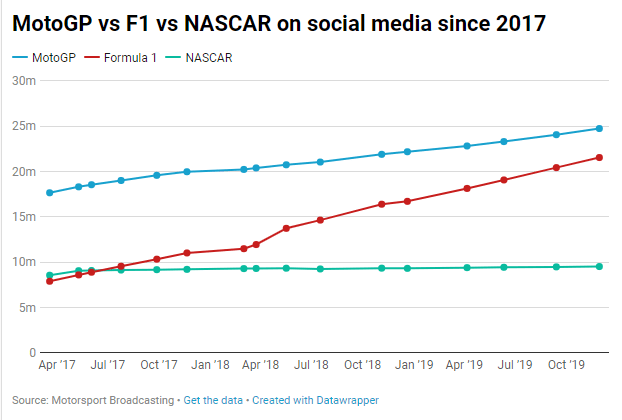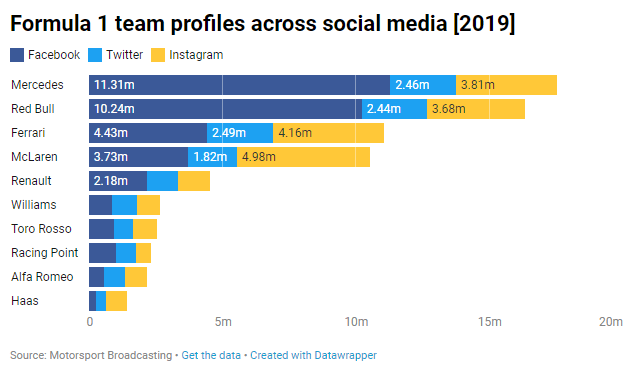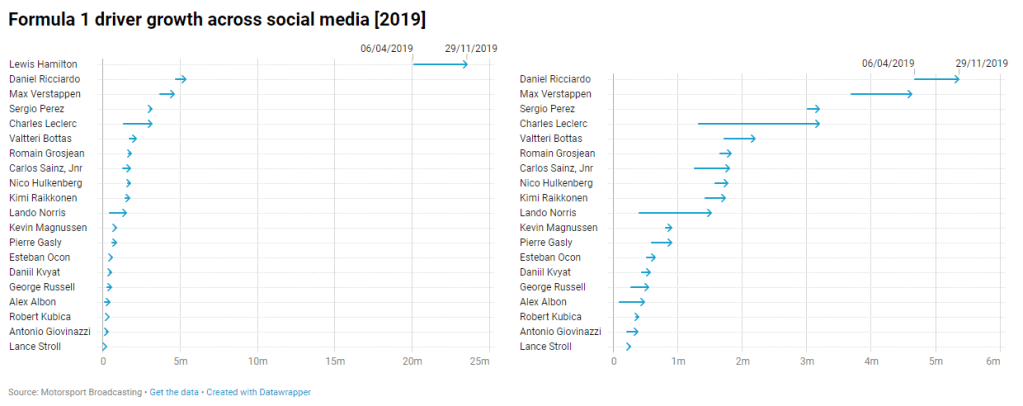Motorsport Broadcasting has dissected social media figures over the past six years, looking across the landscape at what has happened, and what we should be looking out for next.
As always when analysing social media data, it is not about the month-by-month changes, but rather looking at the longer-term trend across the year, and in some cases several years. Across the social platforms, the trend from a motor sport perspective remains the same: Instagram is ever more important, Facebook is stable, whilst Twitter is on the decline.
How well are stakeholders reacting to the change? We take a deep dive below the headlines to see what we can find…
A little health warning to begin that the three sections below use different time periods for the comparisons:
- Championships – comparing data from December 20th, 2018
- Teams – comparing data from July 1st, 2018
- Drivers – comparing data from April 6th, 2019
We use publicly available data for this analysis, such as the number of followers. Whilst the figures presented do not give a reliable indicator as to the engagement per series, the figures do give an idea as to whether a championship or team is attracting a new audience, which is critical for the growth of the sport moving forward.
F1 set to overtake MotoGP in 2020
The big news is that Motorsport Broadcasting predicts that Formula 1 will overtake MotoGP to become the biggest motor sport series on social media in the latter stages of 2020, a remarkable achievement considering how far F1 has come in recent years in comparison to the bike series.
In the past year, F1’s following across the three main social media platforms has increased by 28.9 percent from 16.73 million to 21.56 million followers. In contrast, MotoGP’s following has increased by 11.5 percent, from 22.20 million to 24.76 million followers, which is still strong in isolation.
MotoGP’s following skews towards Facebook, whereas F1 is more split across Facebook, Twitter and Instagram. F1 is clearly hitting the right buttons on social media, attracting a new audience to their social channels, and rightly so given the amount they are investing in it.
The challenge for MotoGP is to adapt their social media offering. F1’s social media offering in 2019 is distinctly un-corporate, almost making MotoGP look old school which is not an observation you would make even two years ago.
Second best is not a bad position to be in, and MotoGP would be far ahead of every other motor racing series in that scenario. But, now is probably the time for the leading bike series to overhaul their offer heading into the 2020 season. The same statement applies for NASCAR…
2019 has been another excellent year for the World Rally Championship, with their reach increasing by 15.8 percent, from 3.59 million to 4.16 million followers. An increased focus on Instagram helped their audience swell by 59.5 percent to 1.17 million followers, pushing the championship ahead of NASCAR on the image-sharing platform.
Formula E also gained massively during 2019, jumping by 47.8 percent from 1.65 million followers to 2.44 million followers, overtaking World Superbikes, the World Touring Car Cup, and the IndyCar Series.
However, Formula E’s following has stalled at around 1.6 million likes on Facebook (unusual considering the significant growth directly preceding it), although Instagram continues to grow solidly for the electric series.
The series has made significant noise in recent days with the announcement that they are teaming up with South Korean boy band BTS.
A tweet announcing the collaboration generated over 80,000 retweets and 150,000 likes, by far the largest ever motor sport related tweet. It will be interesting to see if the announcement results in any new followers for Formula E.
Further down the pecking order, Formula Two had a good year on social media, but there is a sad explanation behind the gain.
The F1 feeder series has seen their following double from 265,000 followers to 536,000 followers, but additional analysis from Motorsport Broadcasting shows that traffic towards their channels surged following the death of Anthoine Hubert during the Belgian Grand Prix weekend in August.
Williams and Racing Point on-track struggles hurt social performance
A poor year on-track for the Williams and Racing Point Formula 1 outfits has continued off the circuit, with little social media growth, despite Poland’s Robert Kubica returning to F1 for the former.
The teams, based at Grove and Silverstone respectively, have seen their portfolio of channels grow by just 400,000 followers (or 19 percent) across the past 18 months. As a result, Racing Point have dropped behind Toro Rosso (soon to be re-branded AlphaTauri), with Alfa Romeo now snapping at Racing Point’s heels.
On Instagram, Racing Point’s growth is the lowest of the whole grid, whilst Williams hold that stat over on Twitter.
It is unlikely Toro Rosso could overtake Renault any time soon however, as Renault sit in Class 1.5 on their own, six million followers behind the top four, but over two million followers ahead of Williams.
The gulf between Class 1 and Class 2 shows no sign of slowing, with Mercedes, Red Bull, Ferrari, and McLaren continuing to record healthy social media growth. The four teams have each increased their total following by between 2.5 and 3 million followers in the past 18 months, dwarfing the rest of the field.
What is fascinating is the profile of the four teams across social media. On Facebook, Mercedes is comfortably king with 11.31 million likes, but Red Bull continues to record sizeable increases, jumping from 9.05 million likes to 10.24 million likes since Summer 2018.
Over on Instagram it is McLaren setting the standard, increasing their following by 91.8 percent, jumping from 2.60 million followers to 4.98 million followers, numbers undoubtedly helped by both of their drivers having a large presence on the platform.
Hamilton continues to reign supreme
Threatened by lawyers in the previous era, one driver continues to stand head and shoulders above the rest of the pack.
Since April, Lewis Hamilton’s Instagram following has jumped by 3.26 million followers, from 10.47 million to 13.73 million, a simply staggering amount of growth.
Only Ferrari’s Charles Leclerc could claim to be remotely close in terms of raw growth (from a much lower base too), moving the needle from 1.01 million to 2.60 million followers, an increase of 1.59 million.
In his second season, Leclerc is already the fourth most popular driver on Instagram, behind Hamilton, Max Verstappen, and Daniel Ricciardo, with much more growth possible for the Monegasque driver.
Across Facebook, Twitter and Instagram, Hamilton’s 23.56 million follower tally is greater than the next seven F1 drivers combined, covering Ricciardo, Verstappen, Leclerc, Sergio Perez, Valtteri Bottas, Romain Grosjean and Carlos Sainz. It is ever more pertinent that rivals challenge Hamilton harder than ever for his crown in 2020.
Instagram is the main contributor to Hamilton’s social media growth, with little gains for the six-time champion on Facebook or Twitter.
Leclerc is the fastest growing driver on Facebook, but with an increase of only 91,000 likes since April, whilst McLaren rookie Lando Norris takes the honours on Twitter, increasing by 211,000 followers. Intagram is clearly the place to be for personality driven content, as the figures show.
Moving forward, Norris and Leclerc are the drivers to watch, having grown in total on social media by 1.12 million followers (or 280 percent) and 1.89 million followers (or 144 percent) respectively. Both are very young, and immensely popular with their fan bases on Instagram.
In comparison, Verstappen’s following has increased by 941,000 accounts. Whilst consistent, Verstappen’s growth is way behind the brand that Hamilton has built up over the past ten years.
Hamilton’s brand is awesome for F1, but could become detrimental if he retires on top, devaluing the rest of the competition in the process. In my view, dethroning Hamilton is important to elevate someone beyond the glass ceiling in the eyes of the wider public.
2020 looks set to be a fascinating year on the social media front, with F1 set to usurp MotoGP on top, Formula E continuing to make strong gains, and the new generation making an impact on the F1 front. It is all to play for…
Contribute to the running costs of Motorsport Broadcasting by donating via PayPal



One thought on “F1 surges towards MotoGP in the social media stakes”